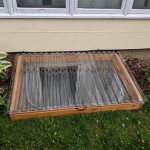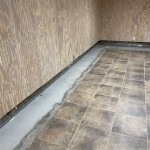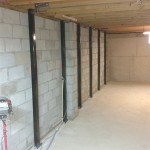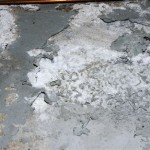What Would Cause A Basement Floor Drain To Back Up Water?
A basement floor drain backing up water is a common plumbing problem that can cause significant inconvenience and potential property damage. Understanding the causes of this issue is crucial for effective troubleshooting and prevention. Basement floor drains are designed to remove excess water from the basement, preventing flooding and maintaining a dry environment. When they malfunction, water can accumulate, leading to dampness, mold growth, and damage to stored items. The backflow often indicates a blockage or a problem within the drainage system, requiring investigation and prompt action.
The functionality of a basement floor drain is dependent on a properly functioning drainage system that effectively carries water away from the property. Several factors can disrupt this system, leading to backups. Identifying the specific cause necessitates a comprehensive understanding of the plumbing network connected to the drain and the environmental factors that can contribute to blockages. This includes examining the drain itself, the pipes leading away from it, and the broader municipal sewer system (if applicable).
Pinpointing the source of the backup is the first step in resolving the issue. This may involve visual inspection, the use of plumbing tools, or even professional assistance from a qualified plumber. Addressing the root cause, rather than simply clearing the immediate backup, is essential to prevent recurring problems and maintain a properly functioning drainage system.
Blockages in the Drain Line
One of the most frequent causes of a basement floor drain backing up water is a blockage within the drain line itself. This blockage can be composed of various materials that accumulate over time. Common culprits include hair, soap scum, dirt, debris, and even small objects that accidentally fall into the drain. These materials, when combined with grease and other sticky substances, can form a solid mass that restricts water flow.
Over time, the accumulation of these materials narrows the diameter of the drain pipe, reducing its capacity to handle water effectively. This constriction can lead to a gradual buildup of water, eventually resulting in a noticeable backup. The severity of the blockage can range from a partial restriction to a complete obstruction, depending on the amount and type of material involved.
Identifying a blockage in the drain line often involves a process of elimination. Visual inspection of the drain opening can sometimes reveal obvious obstructions. However, more often than not, the blockage is located further down the pipe, requiring specialized tools for detection and removal. Plungers and drain snakes are commonly used to dislodge or break up blockages within the drain line. For more stubborn blockages, chemical drain cleaners might be considered, although caution is advised due to their potential to damage pipes over time and their environmental impact.
Preventing drain line blockages requires regular maintenance. Periodically flushing the drain with hot water can help to dissolve grease and prevent the buildup of soap scum. Using drain screens or strainers can effectively capture hair and debris before they enter the drain pipe. Avoiding the disposal of grease, food scraps, and other inappropriate materials down the drain is also crucial for maintaining a clear drain line.
Sewer Line Issues
A basement floor drain backup can also be indicative of a problem within the main sewer line. The sewer line is responsible for carrying wastewater away from the property and connecting it to the municipal sewer system or a private septic tank. When the sewer line becomes blocked or damaged, wastewater can back up into the lowest point in the plumbing system, which is often the basement floor drain.
Common causes of sewer line problems include root intrusion, collapsed pipes, and the accumulation of grease and debris. Root intrusion is a particularly common issue, especially in older homes with clay or cast iron sewer lines. Tree roots are attracted to the moisture and nutrients found within the sewer line and can gradually penetrate the pipe joints, leading to blockages and eventual damage.
Collapsed sewer lines can occur due to age, ground movement, or external pressure. A collapsed pipe can completely obstruct the flow of wastewater, causing a severe backup. The accumulation of grease and debris within the sewer line can also contribute to blockages, particularly in areas with high usage or where proper waste disposal practices are not followed.
Identifying a sewer line issue often requires professional assistance. A plumber can use a sewer camera to inspect the inside of the sewer line and identify the location and nature of the blockage or damage. Depending on the severity of the problem, solutions may include snaking the sewer line, hydro jetting (using high-pressure water to clear blockages), or even excavating and replacing the damaged section of pipe.
Preventing sewer line problems involves several strategies. Avoiding the disposal of grease and food scraps down the drain is crucial. Planting trees and shrubs away from the sewer line can help to prevent root intrusion. Regular sewer line inspections can also help to identify potential problems early on, allowing for timely repairs and preventing more serious issues.
Excessive Rainfall and External Factors
In certain situations, a basement floor drain backup can be caused by excessive rainfall or other external factors that overwhelm the drainage system. During heavy rainstorms, the ground can become saturated, and stormwater runoff can enter the sewer system, increasing the volume of water flowing through the pipes. If the sewer system is unable to handle the increased volume, it can lead to backups in low-lying areas, such as basements.
Another external factor that can contribute to basement floor drain backups is a high water table. The water table is the upper level of groundwater beneath the earth's surface. In areas with a high water table, groundwater can seep into the sewer system through cracks and leaks in the pipes, increasing the overall volume of water that the system must handle. This can be particularly problematic during periods of heavy rainfall when the water table is already elevated.
Furthermore, improper grading around the foundation of the house can contribute to basement flooding and floor drain backups. If the ground slopes towards the house, rainwater can pool around the foundation, increasing the risk of water entering the basement through cracks and leaks. This excess water can then overwhelm the floor drain, leading to a backup.
Addressing these external factors requires a combination of strategies. Improving drainage around the foundation of the house, such as installing gutters and downspouts that direct water away from the building, can help to reduce the amount of stormwater runoff that enters the sewer system. Properly grading the soil around the foundation to ensure that it slopes away from the house can also help to prevent water from pooling around the foundation.
In areas with a high water table, installing a sump pump can help to remove excess groundwater from around the foundation and prevent it from entering the basement. A sump pump is a device that is installed in a pit in the basement floor. It automatically pumps water out of the pit and away from the house, helping to keep the basement dry. In some cases, a backwater valve may be installed on the drain line to prevent sewage from backing up into the basement during periods of heavy rainfall or sewer system overload.
Additionally, ensuring the proper functioning of municipal storm drains is crucial. Clogged storm drains can exacerbate flooding and backups, as they prevent rainwater from effectively draining away from the area. Regular maintenance and cleaning of storm drains are essential for maintaining a properly functioning drainage system.
Basement floor drain backups can stem from a variety of causes, ranging from simple blockages in the drain line to more complex issues within the sewer system or external environmental factors. Understanding these potential causes is essential for effective troubleshooting and prevention. Regular maintenance, proper waste disposal practices, and prompt attention to any signs of drainage problems can help to prevent basement floor drain backups and maintain a dry and healthy basement environment.

Why Does My Floor Drain Back Up Structure Tech Home Inspections

Why Does My Floor Drain Back Up Structure Tech Home Inspections

Sewer Backup Basement Drain Flood Causes Cyclone Valves

Basement Drain Backing Up Here S What To Do Right Now Servicemaster

Basement Drain Backing Up Here S What To Do Right Now Servicemaster

Basement Drain Backing Up Here S What To Do Right Now Servicemaster

Why Did My Basement Floor Drain Back Up 1 Tom Plumber

Sewer Backup Basement Drain Flood Causes Cyclone Valves

Basement Drain Backing Up In Winter Top Causes Solutions

How To Fix Basement Floor Drain Backing Up Avalon Home Inspections
Related Posts







